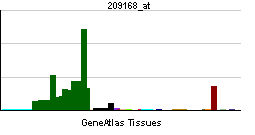GPM6B
| Glycoprotein M6B | |||||||||||
|---|---|---|---|---|---|---|---|---|---|---|---|
| Identifiers | |||||||||||
| Symbols | GPM6B ; M6B; MGC17150; MGC54284 | ||||||||||
| External IDs | Template:OMIM5 Template:MGI HomoloGene: 56966 | ||||||||||
| |||||||||||
| RNA expression pattern | |||||||||||
 | |||||||||||
 | |||||||||||
 | |||||||||||
| More reference expression data | |||||||||||
| Orthologs | |||||||||||
| Template:GNF Ortholog box | |||||||||||
| Species | Human | Mouse | |||||||||
| Entrez | n/a | n/a | |||||||||
| Ensembl | n/a | n/a | |||||||||
| UniProt | n/a | n/a | |||||||||
| RefSeq (mRNA) | n/a | n/a | |||||||||
| RefSeq (protein) | n/a | n/a | |||||||||
| Location (UCSC) | n/a | n/a | |||||||||
| PubMed search | n/a | n/a | |||||||||
Glycoprotein M6B, also known as GPM6B, is a human gene.[1]
References
Further reading
- Yan Y, Lagenaur C, Narayanan V (1993). "Molecular cloning of M6: identification of a PLP/DM20 gene family". Neuron. 11 (3): 423–31. PMID 8398137.
- Olinsky S, Loop BT, DeKosky A; et al. (1996). "Chromosomal mapping of the human M6 genes". Genomics. 33 (3): 532–6. doi:10.1006/geno.1996.0231. PMID 8661015.
- Narayanan V, Olinsky S, Dahle E; et al. (1998). "Mutation analysis of the M6b gene in patients with Rett syndrome". Am. J. Med. Genet. 78 (2): 165–8. PMID 9674909.
- Yoshida M, Shan WS, Colman DR (1999). "Conserved and divergent expression patterns of the proteolipid protein gene family in the amphibian central nervous system". J. Neurosci. Res. 57 (1): 13–22. PMID 10397631.
- Hartley JL, Temple GF, Brasch MA (2001). "DNA cloning using in vitro site-specific recombination". Genome Res. 10 (11): 1788–95. PMID 11076863.
- Wiemann S, Weil B, Wellenreuther R; et al. (2001). "Toward a catalog of human genes and proteins: sequencing and analysis of 500 novel complete protein coding human cDNAs". Genome Res. 11 (3): 422–35. doi:10.1101/gr.154701. PMID 11230166.
- Werner H, Dimou L, Klugmann M; et al. (2002). "Multiple splice isoforms of proteolipid M6B in neurons and oligodendrocytes". Mol. Cell. Neurosci. 18 (6): 593–605. doi:10.1006/mcne.2001.1044. PMID 11749036.
- Strausberg RL, Feingold EA, Grouse LH; et al. (2003). "Generation and initial analysis of more than 15,000 full-length human and mouse cDNA sequences". Proc. Natl. Acad. Sci. U.S.A. 99 (26): 16899–903. doi:10.1073/pnas.242603899. PMID 12477932.
- Ota T, Suzuki Y, Nishikawa T; et al. (2004). "Complete sequencing and characterization of 21,243 full-length human cDNAs". Nat. Genet. 36 (1): 40–5. doi:10.1038/ng1285. PMID 14702039.
- Henneke M, Wehner LE, Hennies HC; et al. (2005). "Mutation analysis of the M6b gene in patients with Pelizaeus-Merzbacher-like syndrome". Am. J. Med. Genet. A. 128 (2): 156–8. doi:10.1002/ajmg.a.30068. PMID 15214007.
- Gerhard DS, Wagner L, Feingold EA; et al. (2004). "The status, quality, and expansion of the NIH full-length cDNA project: the Mammalian Gene Collection (MGC)". Genome Res. 14 (10B): 2121–7. doi:10.1101/gr.2596504. PMID 15489334.
- Wiemann S, Arlt D, Huber W; et al. (2004). "From ORFeome to biology: a functional genomics pipeline". Genome Res. 14 (10B): 2136–44. doi:10.1101/gr.2576704. PMID 15489336.
- Mehrle A, Rosenfelder H, Schupp I; et al. (2006). "The LIFEdb database in 2006". Nucleic Acids Res. 34 (Database issue): D415–8. doi:10.1093/nar/gkj139. PMID 16381901.
| This protein-related article is a stub. You can help Wikipedia by expanding it. |